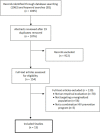Do combination HIV prevention programmes result in increased empowerment, inclusion and agency to demand equal rights for marginalised populations in low-income and middle-income countries? A systematic review
- PMID: 31673432
- PMCID: PMC6797339
- DOI: 10.1136/bmjgh-2019-001560
Do combination HIV prevention programmes result in increased empowerment, inclusion and agency to demand equal rights for marginalised populations in low-income and middle-income countries? A systematic review
Abstract
Introduction: This systematic review aims to determine if combination HIV prevention programmes include outcome measures for empowerment, inclusion and agency to demand equal rights and measure the relationship between empowerment and HIV prevention outcomes.
Methods: An electronic literature search of PubMed, POPLINE, Index Medicus and Google Scholar was conducted between August and October 2018. We included studies that evaluated combination prevention programmes that had all three types of intervention components and that specifically serve members of populations disproportionately affected by HIV published from 2008 to 2018. The selected studies were screened for inclusion, and relevant data abstracted, assessed for bias and synthesised.
Results: This review included a total of 15 studies. Findings indicate that combination HIV prevention programmes for marginalised populations have delivered a variety of theory-based behavioural and structural interventions that support improvements in empowerment, inclusion and agency. However, empowerment, inclusion and least of all agency are not measured consistently or in a standardised way. In addition, analysis of their relationships with HIV prevention outcomes is rare. Out of our 15 included studies, only two measured a relationship between an empowerment, inclusion or agency outcome and an HIV prevention outcome.
Conclusion: These findings suggest that policy-makers, programme planners and researchers might need to consider the intermediate steps on the pathway to increased condom use and HIV testing so as to explain the 'how' of their achievements and inform future investments in HIV prevention. This will support replication and expansion of programmes and ensure sustainability of the programmes.
Prospero registration number: CRD42018106909.
Keywords: HIV; human rights; intervention; key and marginalised populations; low-and middle-income countries; prevention.
© Author(s) (or their employer(s)) 2019. Re-use permitted under CC BY-NC. No commercial re-use. See rights and permissions. Published by BMJ.
Conflict of interest statement
Competing interests: None declared.
Figures
Similar articles
-
The Effectiveness of Integrated Care Pathways for Adults and Children in Health Care Settings: A Systematic Review.JBI Libr Syst Rev. 2009;7(3):80-129. doi: 10.11124/01938924-200907030-00001. JBI Libr Syst Rev. 2009. PMID: 27820426
-
Beyond the black stump: rapid reviews of health research issues affecting regional, rural and remote Australia.Med J Aust. 2020 Dec;213 Suppl 11:S3-S32.e1. doi: 10.5694/mja2.50881. Med J Aust. 2020. PMID: 33314144
-
Demand-side financing measures to increase maternal health service utilisation and improve health outcomes: a systematic review of evidence from low- and middle-income countries.JBI Libr Syst Rev. 2012;10(58):4165-4567. doi: 10.11124/jbisrir-2012-408. JBI Libr Syst Rev. 2012. PMID: 27820523
-
Reducing obesity and related chronic disease risk in children and youth: a synthesis of evidence with 'best practice' recommendations.Obes Rev. 2006 Feb;7 Suppl 1:7-66. doi: 10.1111/j.1467-789X.2006.00242.x. Obes Rev. 2006. PMID: 16371076 Review.
-
An extensive literature review of the evaluation of HIV prevention programmes.Health Educ Res. 1996 Sep;11(3):327-38. doi: 10.1093/her/11.3.327. Health Educ Res. 1996. PMID: 10163565 Review.
Cited by
-
Outcomes of a community-led online-based HIV self-testing demonstration among cisgender men who have sex with men and transgender women in the Philippines during the COVID-19 pandemic: a retrospective cohort study.BMC Public Health. 2022 Feb 21;22(1):366. doi: 10.1186/s12889-022-12705-z. BMC Public Health. 2022. PMID: 35189850 Free PMC article.
-
Bridging the knowledge gap of biomedical HIV prevention tools among sub-saharan african immigrants in France. Results from an empowerment-based intervention.SSM Popul Health. 2023 Jul 23;23:101468. doi: 10.1016/j.ssmph.2023.101468. eCollection 2023 Sep. SSM Popul Health. 2023. PMID: 37560089 Free PMC article.
-
Promoting women's and children's health through community groups in low-income and middle-income countries: a mixed-methods systematic review of mechanisms, enablers and barriers.BMJ Glob Health. 2019 Dec 5;4(6):e001972. doi: 10.1136/bmjgh-2019-001972. eCollection 2019. BMJ Glob Health. 2019. PMID: 31908874 Free PMC article.
-
Feasibility and preliminary effectiveness of integrating HIV prevention into an adolescent empowerment and livelihood intervention at youth clubs in rural Uganda.AIDS Care. 2023 Jan;35(1):41-47. doi: 10.1080/09540121.2022.2147480. Epub 2022 Dec 6. AIDS Care. 2023. PMID: 36473203 Free PMC article.
-
Explaining inequity in knowledge, attitude, and services related to HIV/AIDS: a systematic review.BMC Public Health. 2024 Jul 8;24(1):1815. doi: 10.1186/s12889-024-19329-5. BMC Public Health. 2024. PMID: 38978024 Free PMC article.
References
-
- Women UN. Sdg 5: achieve gender equality and empower all women and girls. New York: UN Women, 2017.
-
- Hanmer L, Klugman J. Exploring women's agency and Empowerment in developing countries: where do we stand? Fem Econ 2016;22:237–63. 10.1080/13545701.2015.1091087 - DOI
LinkOut - more resources
Full Text Sources

